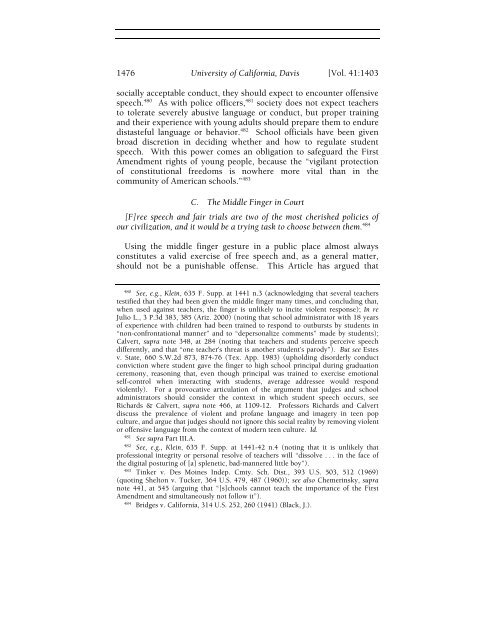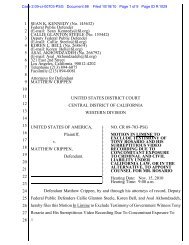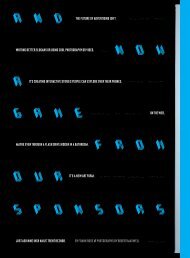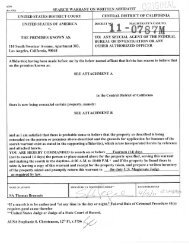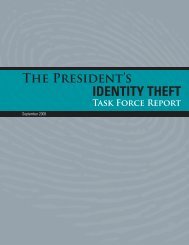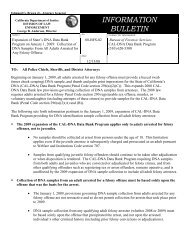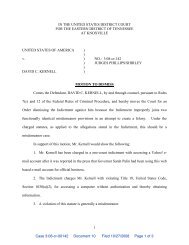Digitus Impudicus: The Middle Finger and the Law - Wired
Digitus Impudicus: The Middle Finger and the Law - Wired
Digitus Impudicus: The Middle Finger and the Law - Wired
You also want an ePaper? Increase the reach of your titles
YUMPU automatically turns print PDFs into web optimized ePapers that Google loves.
1476 University of California, Davis [Vol. 41:1403<br />
socially acceptable conduct, <strong>the</strong>y should expect to encounter offensive<br />
speech. 480 As with police officers, 481 society does not expect teachers<br />
to tolerate severely abusive language or conduct, but proper training<br />
<strong>and</strong> <strong>the</strong>ir experience with young adults should prepare <strong>the</strong>m to endure<br />
distasteful language or behavior. 482 School officials have been given<br />
broad discretion in deciding whe<strong>the</strong>r <strong>and</strong> how to regulate student<br />
speech. With this power comes an obligation to safeguard <strong>the</strong> First<br />
Amendment rights of young people, because <strong>the</strong> “vigilant protection<br />
of constitutional freedoms is nowhere more vital than in <strong>the</strong><br />
community of American schools.” 483<br />
C. <strong>The</strong> <strong>Middle</strong> <strong>Finger</strong> in Court<br />
[F]ree speech <strong>and</strong> fair trials are two of <strong>the</strong> most cherished policies of<br />
our civilization, <strong>and</strong> it would be a trying task to choose between <strong>the</strong>m. 484<br />
Using <strong>the</strong> middle finger gesture in a public place almost always<br />
constitutes a valid exercise of free speech <strong>and</strong>, as a general matter,<br />
should not be a punishable offense. This Article has argued that<br />
480 See, e.g., Klein, 635 F. Supp. at 1441 n.3 (acknowledging that several teachers<br />
testified that <strong>the</strong>y had been given <strong>the</strong> middle finger many times, <strong>and</strong> concluding that,<br />
when used against teachers, <strong>the</strong> finger is unlikely to incite violent response); In re<br />
Julio L., 3 P.3d 383, 385 (Ariz. 2000) (noting that school administrator with 18 years<br />
of experience with children had been trained to respond to outbursts by students in<br />
“non-confrontational manner” <strong>and</strong> to “depersonalize comments” made by students);<br />
Calvert, supra note 348, at 284 (noting that teachers <strong>and</strong> students perceive speech<br />
differently, <strong>and</strong> that “one teacher’s threat is ano<strong>the</strong>r student’s parody”). But see Estes<br />
v. State, 660 S.W.2d 873, 874-76 (Tex. App. 1983) (upholding disorderly conduct<br />
conviction where student gave <strong>the</strong> finger to high school principal during graduation<br />
ceremony, reasoning that, even though principal was trained to exercise emotional<br />
self-control when interacting with students, average addressee would respond<br />
violently). For a provocative articulation of <strong>the</strong> argument that judges <strong>and</strong> school<br />
administrators should consider <strong>the</strong> context in which student speech occurs, see<br />
Richards & Calvert, supra note 466, at 1109-12. Professors Richards <strong>and</strong> Calvert<br />
discuss <strong>the</strong> prevalence of violent <strong>and</strong> profane language <strong>and</strong> imagery in teen pop<br />
culture, <strong>and</strong> argue that judges should not ignore this social reality by removing violent<br />
or offensive language from <strong>the</strong> context of modern teen culture. Id.<br />
481 See supra Part III.A.<br />
482 See, e.g., Klein, 635 F. Supp. at 1441-42 n.4 (noting that it is unlikely that<br />
professional integrity or personal resolve of teachers will “dissolve . . . in <strong>the</strong> face of<br />
<strong>the</strong> digital posturing of [a] splenetic, bad-mannered little boy”).<br />
483 Tinker v. Des Moines Indep. Cmty. Sch. Dist., 393 U.S. 503, 512 (1969)<br />
(quoting Shelton v. Tucker, 364 U.S. 479, 487 (1960)); see also Chemerinsky, supra<br />
note 441, at 545 (arguing that “[s]chools cannot teach <strong>the</strong> importance of <strong>the</strong> First<br />
Amendment <strong>and</strong> simultaneously not follow it”).<br />
484 Bridges v. California, 314 U.S. 252, 260 (1941) (Black, J.).


